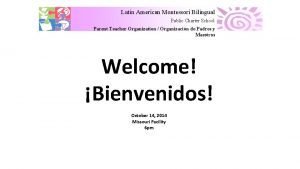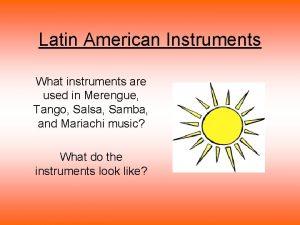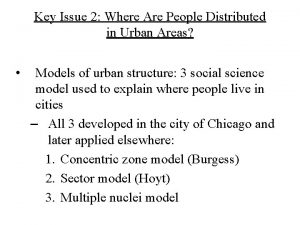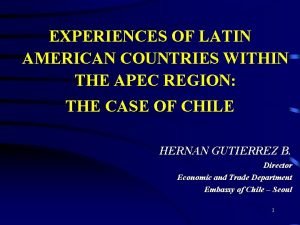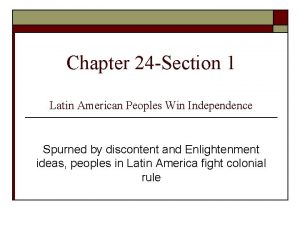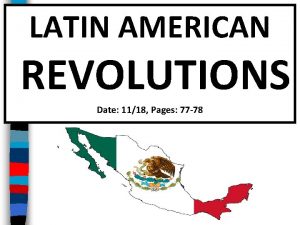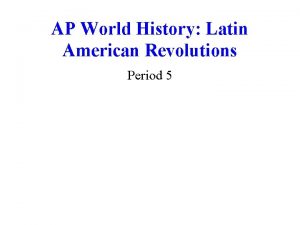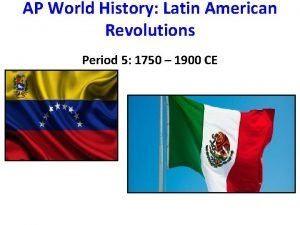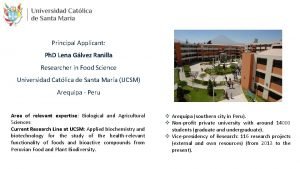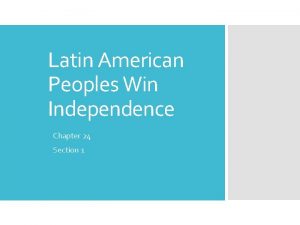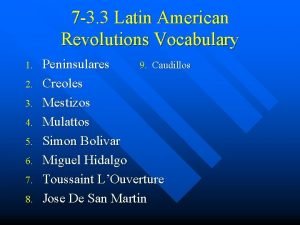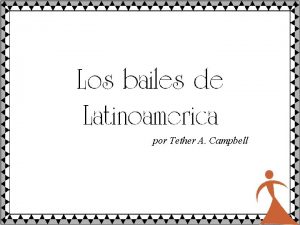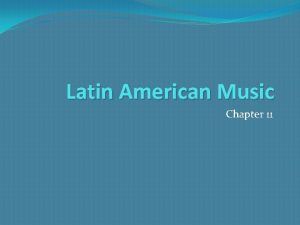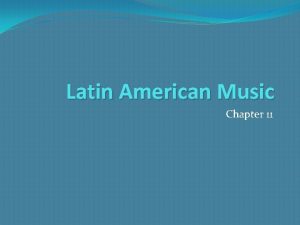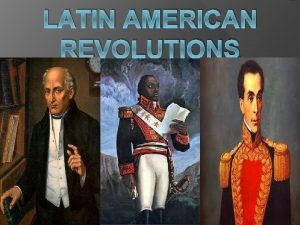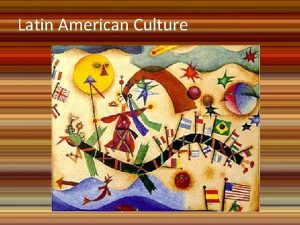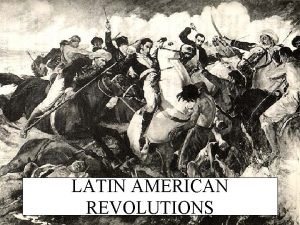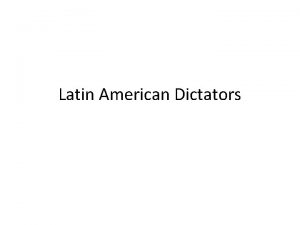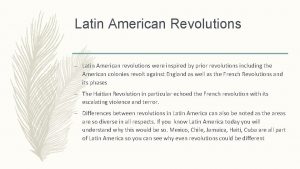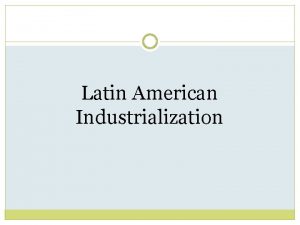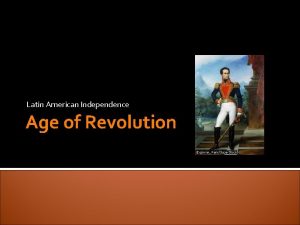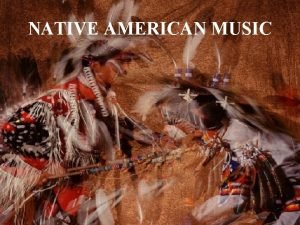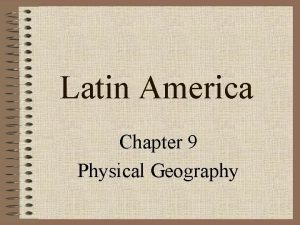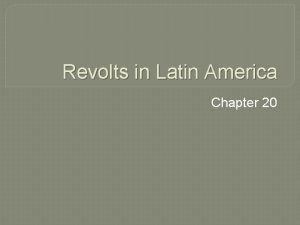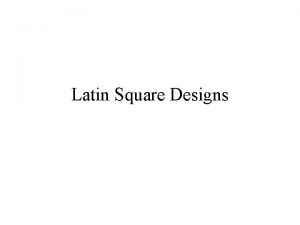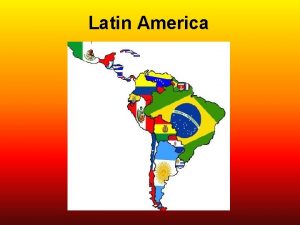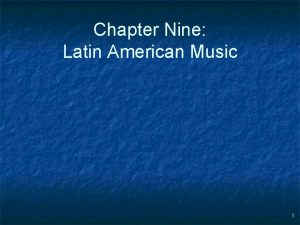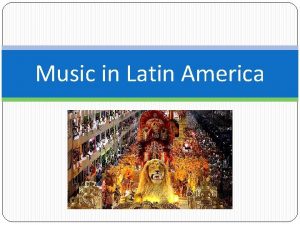Latin American Music Chapter 11 Latin AmericaLatin Music




























- Slides: 28

Latin American Music Chapter 11

Latin America/Latin Music �Here, “Latin Music” = Latin American Music �Latin America = “large and culturally diverse region of the world encompassing all of South America and the various nations and territories of Central America, Mexico, and the Caribbean” �(N. B. Some scholars include only Spanish/Portuguesespeaking nations – we’ll think more broadly)

Latin American Music Defined � 1. Any music originating from anywhere in this vast region, as well as musics of diasporic Latino communities in North America, Europe, etc. � 2. A host of popular dance-music genres that originated in or derived from the island of Cuba, having experienced significant histories of development in the United States and Puerto Rico, and with histories of transmission closely tied to the U. S. /international commercial music industry and mass media distribution. � Hubs: NYC, Miami, SF, LA, plus Paris, London, and even Tokyo

Whirlwind Survey �Brazil � Portuguese � Samba � Diverse styles, all with African musicultural roots � Common features: � Percussion instruments � Driving rhythms � Polyrhythmic textures � Call-and-response � Improvisational elements � Samba-enredo (theme samba) – Carnaval, Rio de Janeiro � https: //www. youtube. com/watch? v=k. Tc 3 pv 7 d 5 v. Y � Batucada � https: //www. youtube. com/watch? v=j. QLv. Ggha. Db. E

Bossa Nova �South Zone of Rio �Mainly middle-class, white �Samba from favelas surrounding city �Antonio Carlos (Tom) Jobim, Joao and Astrud Gilberto, Stan Getz � 1964—Getz/Gilberto – “Girl from Ipanema” �Batida guitar style (Gilberto) � https: //www. youtube. com/watch? v=c 5 Qf. Xjso. Ne 4 �Laid-back vocals influenced by Frank Sinatra, Sarah Vaughan �CD 1 -27 -- Paul Desmond Quartet “Wave” (Jobim) -- 1974

Cannibalism �Post-1964 “period of crisis” in Brazil �Military coup and subsequent totalitarian regime (US supported) �Beatlemania/British invasion �Cannibalist Manifesto (Oswald de Andrade – 1928) � Lorraine Leu: Manifesto “attacked both a purist view of national culture and wholesale imitation of foreign models…. advocated a selective devouring of elements of foreign culture which would then be absorbed and transformed into Brazilian cultural products. ”

Tropicália �One musical outcome: tropicália �Caetano Veloso, Gilberto Gil � Veloso: “By using electric guitars in melodic compositions with elements of Argentine tango and African things from Bahia, we assumed a posture of ‘being-in-the world’—we rejected the role of the Third World country living in the shadow of more developed countries. ” �Os Mutantes -- “A Minha Menina” (CD 1 -1) � “Bat Macumba” � https: //www. youtube. com/watch? v=Zq. KBCJL 4 GNo � Mini-documentary: https: //www. youtube. com/watch? v=r 6 Uz. HZGZ 4 M

Tango � Argentina (Buenos Aires), Uruguay (Hugo Diaz, “Fueye, ” CD 4 -1) � Dance: “vertical expression of a horizontal desire” � Emerged in the tough, poor, ethnically mixed port district of Buenos Aires among the porteños. � “Golden Age” of tango, 1920 s-30 s � Carlos Gardél � https: //www. youtube. com/watch? v=IQFcpu. Yi 8 L 4

Nuevo Tango �Astor Piazzolla �Bandonéon �Perfomed with Gardel, etc. �Studied composition in Paris with Nadia Boulanger �Nuevo tango style: tango, jazz, new music synthesis � https: //www. youtube. com/watch? v=GZQ_Ywcpo. Iw&list=RDreerrt. J 6 DOQ&index=11 �Yo-Yo Ma group performing Piazzolla’s “Libertango” � https: //www. youtube. com/watch? v=RUAPf_ccobc �“Libertango” – Moscow Philharmonic, tango dancers � https: //www. youtube. com/watch? v=kdh. Todx. H 7 Gw&index=6&list= RDGcxv 7 i 02 l. Xc

Andean Panpipes �Andes: Peru, Bolivia, Ecuador �Ayllu performance, jula, Bolivian Andes � https: //www. youtube. com/watch? v=dx. E 6 Mtt. Sk. CI � CD 4 -2 (Stobart) �Folkoric – CD 2 -6 “Ratita” Ukamau � Roots: Abalos Brothers �Andean folkloric/pop � https: //www. youtube. com/watch? v=Fk. PTi. Jv. JHF 8 �Simon & Garfunkel “El Condor Pasa/If I Could” (Los Incas) [“I’d Rather be a Hammer…”] � https: //www. youtube. com/watch? v=wxc 0 h. Qr. JX 4 A

Mariachi �CD 1 -20 – “Cielito Lindo” �Stereotyping (Frito Bandito) �Mariachi in Los Angeles �Mariachi Los Camperos de Nati Cano � La Fonda (restaurant), Linda Ronstadt Canciones de Mi Padre � https: //www. youtube. com/watch? v=h 9 KQbbhe. Fc. M&list=RD h 9 KQbbhe. Fc. M#t=31

Steel Band (CD 1 -30) �Trinidad and Tobago �Steelpan (pan, steel drum, steel band) � 55 -gallon oil drums �Afro-Trinidadian innovation (post WW II) �Carnival �Like Carnaval in Brazil, associated with Pre-Lenten celebrations (also Mardi Gras, New Orleans) �Panorama competition � https: //www. youtube. com/watch? v=-G 2 o 5 -6 BSi. M

Cuban Roots of Latin Dance Music �Afro-Cuban �Batá drumming (CD 4 -3) � Santéria (Regla de Ocha) – Orisha ritual music � https: //www. youtube. com/watch? v=68 z. Jf. Dc_p. Gc&list=RDid 8 E 60 -n 2 x 8&index=12 �Rumba (CD 4 -4) � Rumba guaguancó � https: //www. youtube. com/watch? v=Ja. Nfdh 0 i. WCg � Clave (rhythm), claves (inst. ), conga drums, palitos

Spanish Roots (Cuba) �Creolized dance styles �Contradanza �Danzón-mambo �Disenchantment with Spanish colonial rule partially inspired the grafting of African-derived elements onto these dances and their musics.

Charanga �“sweet-sounding” ensemble �Wooden flute, two + violins, piano, string bass, guiro, timbales, (maracas) �Became standard ensemble for danzón and later danzónmambo (which added conga drums, bongos, cowbell to timbales “drum set”—influences from son) �Danzón-mambo would ultimately feed into both cha chá and big band mambo, which would in turn coalesce in the style of Tito Puente’s “Oye Como Va, ” to which we will return.

Cha Chá �“El Bodeguero, ” by Enrique Jorrin, performed by Orquesta Aragon (1979) �https: //www. youtube. com/watch? v=ZE 4 ni. TFlds 4&list= RDG 1 FDC 2 QKHNw&index=8 �CD 4 -5 – “El Bodeguero” (Grupo Cimarrón, Cuba) �Traditional arrangement but with synthesizers, no violins

MGT: Latin Percussion Rhythms of the Cha Chá �Timbales �Guiro �Maracas �Congas (tumbao) �Bongó �(Clave)

Mambo (Big Band Mambo) �Pérez Prado “Mambo #5” (1949) �Mambo kings (mambo craze) – early 1950 s, New York �Machito, Tito Puente, Tito Rodríguez �Palladium – Latin dance bands

Big Band Mambo – Musical Style �Mambo style �Big band instrumentation, plus Cuban son percussion section (timbales, congas, bongo, plus cowbells, claves, guiro, maracas, etc. ) �Textures—layered ostinatos throughout band, riffs �Driving, Afro-Cuban percussion rhythms �Jazz influences �Fast tempos, highly energetic playing �Absence, or at least limited use, of singing

Mambo Examples �CD 4 -6, “Sambia, ” by Machito and the Afro-Cubans. �Jazz-style intro, layered riffs/C&R (horns), rhythms �Tito Puente, “Mambo Gozon” �https: //www. youtube. com/watch? v=Un 5 vma. N 3 LMM

“Oye Como Va” – Tito Puente � Brought together the cha chá, big band mambo instrumentation, textures, and stylistic elements � CD 4 -7 Original Tito Puente “Oye Como Va” (1963, El Rey Bravo, pp. 252 -255) � Syncopated organ and bass riffs � Minor key (A minor) distinctive re: other chas � Instrumental mambo sections (w. layered horn riffs) � Flute cha/charanga-like

“Oye Como Va” – Santana � CD 4 -8 (1970, Abraxas, pp. 255 -61) � Latin rock � Same: Tune, key, tempo, text, singing style, cha chá groove, basic form of arrangement � Different: Electric guitar (Carlos S. ) part “replaces” horn section and flute, cha chá + rock drum set, Hammond B-3 (blues/rock style of solo), inst. mambo sections of arrangement “replaced” by improvised guitar and organ solos

Santana – videos �Santana live at Woodstock (“Soul Sacrifice”) �https: //www. youtube. com/watch? v=Aq. Zce. AQSJvc �Santana live, “Oye Como Va” �https: //www. youtube. com/watch? v=v 6 GW 1 Vnlp. IE

Beyond the Music �Santana “Oye” success “revives” Puente’s career �Latin bands decline through 1960 s � Cuba, Castro, Cold War politics � Rock ‘n’ roll, rock, Beatlemania �Santana shifted pendulum �Puente – larger venues, festivals, etc. �Renewed interest in Latin music in U. S. led to salsa and Latin jazz (NYC), 1970 s, with Puente as “king” of both � “Salsa explosion, ” 1970 s �Pan-Latino movement � Crystallized 1970 s � Music, Puente, Santana, plus others (Ruben Blades) significant

Salsa, Latin jazz � Overlapping genres: salsa more singing and dance-oriented, Latin jazz more instrumental and improvisation-oriented � “Salsa explosion, ” 1970 s � Puente, Cruz, Blades, Fania All-Stars, Aguabella, etc. � “Qimbara” – Celia Cruz, Tito Puente, Poncho Sanchez � https: //www. youtube. com/watch? v=Zm 2 C 5 hx 4 s. I 0 � Fania All-Stars, Yankee Stadium, 1973 (start at 4: 54) � https: //www. youtube. com/watch? v=ya. G_8 t. Flwlk&list=RDya. G_8 t. Flwlk#t=3 � Rubén Blades (start at 6: 17), Panama � https: //www. youtube. com/watch? v=caj. Sy. Wb. CTWU � Francisco Aguabella (CD 4 -9 “Nena” )Latin Jazz Band, “Yesterdays” � https: //www. youtube. com/watch? v=e. Pr. Q 7 mffv. DA � Aguabella, Giovanni Hidalgo, Anthony Carrillo (bongó) feat. w. Eddie Palmieri (percussion feature 3: 07 -4: 32) � https: //www. youtube. com/watch? v=X 5 t 2 o. XWe. ZJc

Stars and Legends

Tito Puente Jr. “Oye Como Va” �CD 4 -10 Tito Puente Jr. “Oye Como Va” (2004 – TPJ: Greatest Club Remixes) �Original: Guarachando (1996) �La India, Tito Puente (Sr. ) �Synths replace horns (simplified riffs) �Solos: timbales (no melodic insts) �Sampled/heavily processed B 3 �“Latin dance”/cha chá grooves �TPJ band live “Oye Como Va” (traditional style) �https: //www. youtube. com/watch? v=IF-A-SBRWDc �Last-ever live performance of “Oye” by Tito Puente �https: //www. youtube. com/watch? v=z. ZQh 4 IL 7 un. M

 Music music music
Music music music Latin american peoples win independence chapter 8 section 1
Latin american peoples win independence chapter 8 section 1 Filipino music history
Filipino music history Classical music vs romantic music
Classical music vs romantic music Beats organized into recognizable accent patterns
Beats organized into recognizable accent patterns Music that employs electronic music
Music that employs electronic music Ilocano name for the wind instrument
Ilocano name for the wind instrument Southeast asian urban model
Southeast asian urban model Social classes in ancient japan
Social classes in ancient japan Core periphery model
Core periphery model Latin american city model history
Latin american city model history Latin american montessori bilingual public charter school
Latin american montessori bilingual public charter school Latin american instruments
Latin american instruments Latin american urban model
Latin american urban model Latin america city model
Latin america city model What are the experiences of latin american countries
What are the experiences of latin american countries Latin american peoples win independence
Latin american peoples win independence Latin american revolutions date
Latin american revolutions date Mexico brazil latin american cbdcsenglercoindesk
Mexico brazil latin american cbdcsenglercoindesk Presebres
Presebres Jose de san martin ap world history
Jose de san martin ap world history Simon bolivar definition ap world history
Simon bolivar definition ap world history Lena gálvez ranilla
Lena gálvez ranilla Latin american peoples win independence
Latin american peoples win independence Physical features of brazil map
Physical features of brazil map Latin american revolution vocabulary
Latin american revolution vocabulary Is magical realism a genre
Is magical realism a genre Latin american model
Latin american model Latin american dances
Latin american dances











